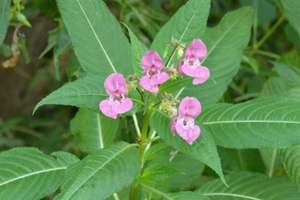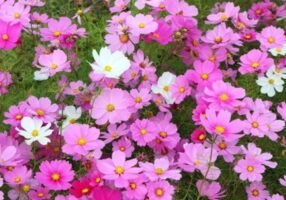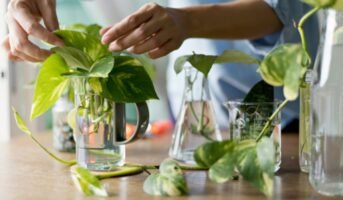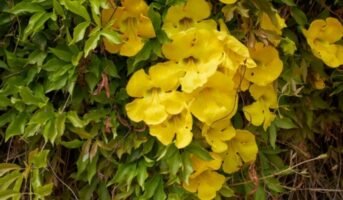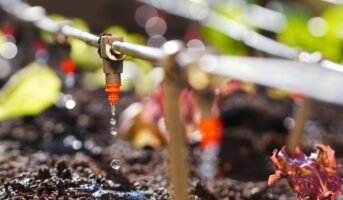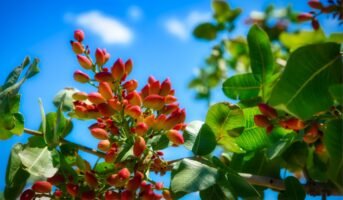Balsam is an annual that is simple to grow. The roughly 1 to 3-inch-wide flowers have a vibrant cup shape. They bloom in the late spring and continue through the first fall frost. The blossoms might be spotted, bicolored, or uniform in colour.
In full sun to partial shade on fertile, porous, well-drained but moist soils, I. balsamina thrives. Balsam tolerates 3–4 hours of direct sunshine nicely. It may grow on various soil types, such as clay, sand, and loamy soils, with a pH range of 5.6 to 7.5. These species do not tolerate frost. It is not tolerant of dry environments well and likes a damp environment. Fertile, well-drained soil is preferred for balsam. It performs best in warm weather and can tolerate moist soil as long as it is not wet.
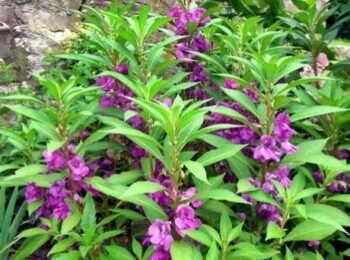
Source: Pinterest
What is a Balsam flower?
Garden balsam, scientifically known as Impatiens balsamina. It is a perennial flower that blooms on tall stems covered in lance-shaped, light-green leaves with serrated edges. It is an evergreen plant. Garden balsam has tall stems that are scarce and support larger double flowers. The colors of flowers include pink, red, white, and light purple. The plants, which can reach heights of 12 to 36 inches, are strong, upright, and narrow.
Balsam flower: Important facts
| Name of species | Impatiens balsamina |
| Taxonomic Tree | Domain: Eukaryota
Kingdom: Plantae Phylum: Spermatophyta Subphylum: Angiospermae Class: Dicotyledonae |
| Family Name | Balsaminaceae |
| Common Name | Balsam, Garden balsam, Rose balsam, Chinese balsam, jewelweed, Touch-me-not, Spotted snap weed, Lady’s slipper |
| Division Of The Plant | Angiosperms (Seed Plants) |
| Category | Annual, Broadleaved, Herbaceous, Seed propagated, Vegetatively propagated |
| Mode of Nutrition | Autotrophic |
| Preferred Climate | Tropical and subTropical regions |
| Native Habitat | Terrestrial, wetlands, forests, forest edges, gardens, yards, and on the side of the road |
| Desirable Plant Features | Ornamental flowers, Ornamental foliage |
| Landscape Uses | Outdoor and also indoor Plant |
| Temperature | Temperature between 15°C – 25°C ( 59°F-64°F) |
| Blooming Time | Summer to fall (May to October) |
Balsam plant: Anatomy
- Stem: The stem is Green, Red, or Burgundy. A robust, straight but delicate stem.
- Leaf: Green color simple leaf. The spirally arranged leaves have a strongly serrated border—elliptical, Lanceolate-shaped leaf. The leaf is 3 – 6 inches long and 1 – 3 inches wide.
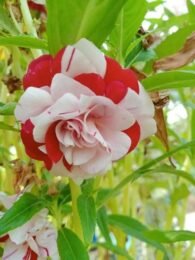
Source: Pinterest
- Flower: The traditional balsam flower has three sepals, two of which are small and green, one of which is irregular and shaped like a petal with a prominent spur, and five petals, which are frequently fused to give the impression that there are three. These come together to form a hooded, round-topped bloom with an ovary in the middle and a blousy, extended lip created by the fused petals. It results in the original popular name for the species, “Lady’s Slipper.” When the petals double or triple, they give the flower a much more rounded, almost fluffy appearance. Hermaphrodite, single to double, cup-shaped flowers measure 1-3 inches. In a few days, the anthers fall out, transforming the flower into a female stage, open to pollination.
- Flower Colour: Pink, Purple/Lavender, Red/Burgundy, White
- Flower Inflorescence: Solitary
- Fruit: Only one Impatiens species produces seed pods developing in pubescence. Capsules start green and turn yellow as they mature. The length and width of the fruit vary from 1-3 inches. They burst and release their seeds when touched. That is why balsam is commonly known as Touch-me-not.
Balsam flower: Habitat and distribution
Native touch-me-not plants can be found in numerous parts of Eastern Asia, including India, China and Myanmar. In several Pacific Ocean islands, these blooms have naturalized and have grown somewhat invasive. As a result, they flourish primarily in villages and other sparsely populated places.
Tropical and subtropical locations are top-rated for growing touch-me-not flowers as ornamental plants.
Balsamina can be found in slightly above sea level environments to 3500 m. In tropical and subtropical parts of the world, this species is frequently grown as an ornamental in gardens. It has naturalized in uncultivated areas like grasslands, streambeds, roads, and other disturbed open areas. Additionally, it is a typical weed in wastelands close to settlements, homes, and cemeteries.
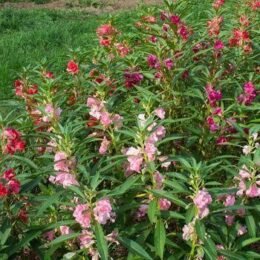
Source: Pinterest
Balsam flower: Cultivation
- Balsams are usually cultivated from seeds. You can either Plant the flower seeds indoors or in a flower garden.
- These balsam seeds are arranged in flats or trays to make later transplantation simpler. About six weeks before the first winter frost, indoor sowing should begin.
- After planting the seeds, Cover the area with 1/8 inch of soil. To keep the soil moist, give the plant plenty of water.
- Balsam will bloom profusely from early to midsummer until the last spring frost. Balsam plants need 10 to 15 days to germinate, so be sure to hydrate the plants regularly throughout this time.
- Preferable Climatic conditions:
- Sun Exposure: Full, partial
- Soil Type: Loamy, moist, well-drained
- Soil pH: Acidic, neutral
- Temperature: Between 15°C – 25°
Is Balsam a summer flower?
Balsam flowers bloom in summers, spring, and fall. They cannot tolerate cold temperatures and are instantly killed by frost. They thrive in warmer temperatures but can wilt in summer heat waves. They also prefer a little humidity but can survive drier air if the soil stays moist.
Is Balsam an indoor plant?
Balsam needs 3-4 hours of direct sunlight. However, it can also survive and bloom in partial shade. To grow it indoors, a south or east-facing location is the most suitable. In fact, it’s highly recommended to keep it indoors during the winters as it cannot tolerate even the slightest of frost.
Balsam flower: Benefits and uses
The Plant’s various parts are utilized as traditional treatments for illnesses and skin conditions.
Uses as food
The blossom, which can be eaten, is used as edible pansy-style decorations for cakes and cookies.
Leaves and young shoots – cooked, Raw, or cooked seeds. They are usually challenging to gather in large numbers because their exploding seed capsules disseminate the ripe seed at the slightest touch.
Medicinal benefits
- Balsam can lessen acidity, and its blossoms are naturally cool.
- The flowers can be ground into a paste used to soothe burns.
- It helps treat arthritis in addition to being diuretic and digestive.
- Additionally, balsam seeds can be used to produce 21% edible oil.
- Powdered balsam seeds are applied during pregnancy in China to facilitate delivery.
- In the Philippines, back pain is also treated with seeds.
- According to several articles, snake and bug bites can be treated with a paste made from balsam leaves.
- The paste is also thought to have expectorant qualities and can be used to treat cancer.
- Balsam flowers can be used to treat bacterial and fungal illnesses.
Value to wildlife:
Attractive to bees, other insects, and nectar-eating birds.
Other uses:
- Impatiens balsamina is often grown as an ornamental because of its lovely blossoms.
- Balsam flowers and leaves can be crushed to give nails color. It has a similar quality to henna.
- This flower is unique in India’s well-known festival honoring the elephant-headed god Lord Ganesha. Also, Goddess Gauri is observed on the third day of this celebration. These balsam flowers are offered to the goddess as part of unique puja offerings. Leaves are frequently used in Ganesh Pooja rituals.
Side effects of Balsam plant: Can balsam flower be eaten?
Due to their high mineral content, consuming these plants in significant quantities might be hazardous.
Raw food consumption in large amounts causes calcium oxalate to build up. As a result, orange stains appear when the stems or blooms are broken off. Deer only consume young seedlings or the newest shoot tips because the Plant uses this chemical to defend against grazing.
People predisposed to rheumatism, arthritis, gout, kidney stones, and hyperacidity should use extra caution when consuming this herb.
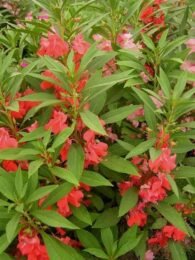
Source: Pinterest
Typical recognizing problem of I. balsamina
Garden balsam is generally free of pests and illnesses, but it occasionally gets aphids and cucumber beetles, which can be controlled with a horticultural oil like neem oil. I. balsamina is also susceptible to powdery mildew.
Invasiveness and control
A particularly problematic invasive non-native plant in the Lake District, Himalayan Balsam smothers and displaces other native plants along riverbanks and lakeshores in large expanses.
After escaping from farming, Impatiens balsamina has naturalized in disturbed areas and semi-natural habitats, including secondary woodlands and forest boundaries. It can grow into dense stands in the forest’s understory, preventing native plant species from establishing seeds and germination. Both seeds and stem fragments are used for vegetative propagation, which is how they spread. Many tropical and subtropical islands are considered to have been invaded.
Control: Using herbicides like 2,4-D, triclopyr, and glyphosate has been suggested.
Conclusion
Garden Balsam’s meaning is “Impatience” or “Impatient for Love” in the Flower Language. Beautiful perennial or annual makes a great houseplant or summer bedding plant. Early in the summer, yearly plants begin to bloom, but perennial species do not. Perennial species, located in cooler climes, can bloom all year, and annual species start to produce flowers in the early summer. It is a simple plant to grow if given access to rich, organic soil.
Garden balsam exploding seed heads efficiently distribute seeds around the garden, which is the most specific criticism. In addition, garden balsam tends to increase, making it a potentially invasive plant, especially in warmer climates with lengthy growth seasons. Before the seed pods develop, remove the spent blossoms to stop this spread. Balsam plants can improve the appearance of your garden layout. By getting colorful plants, you can enhance the appearance of your house. Buy plants solely from nurseries that carry new plants and gardening supplies like soil, fertilizer, etc.
FAQs
Is deadheading of balsam necessary?
Deadheading or removing seed pods as they develop will help balsam bloom continuously throughout the growing season. However, stop pulling the seed pods at least one month before your first typical frost to promote reseeding.
Is this plant still employed as a traditional remedy?
Yes. This Plant has many medical uses, particularly in Asia. Poultices formed by crushing the leaves and blossoms are used as a balm for burns and other skin irritations. It is less prevalent in western folk holistic treatment.
Do cuttings of impatiens take root in water?
Water can also be used to help impatiens root. We are employing this technique to impatiens cuttings root readily. First, clip off any lower leaves and insert the cuttings, up to a few nodes, in a glass or vase of water. Then, put it on a well-lit windowsill or another bright area away from direct sunlight.
Do balsam flowers have a scent?
Balsam plants add beauty and an unforgettable pleasant aroma to the garden when they are present.
Housing News Desk is the news desk of leading online real estate portal, Housing.com. Housing News Desk focuses on a variety of topics such as real estate laws, taxes, current news, property trends, home loans, rentals, décor, green homes, home improvement, etc. The main objective of the news desk, is to cover the real estate sector from the perspective of providing information that is useful to the end-user.
Facebook: https://www.facebook.com/housing.com/
Twitter: https://twitter.com/Housing
Email: [email protected]
